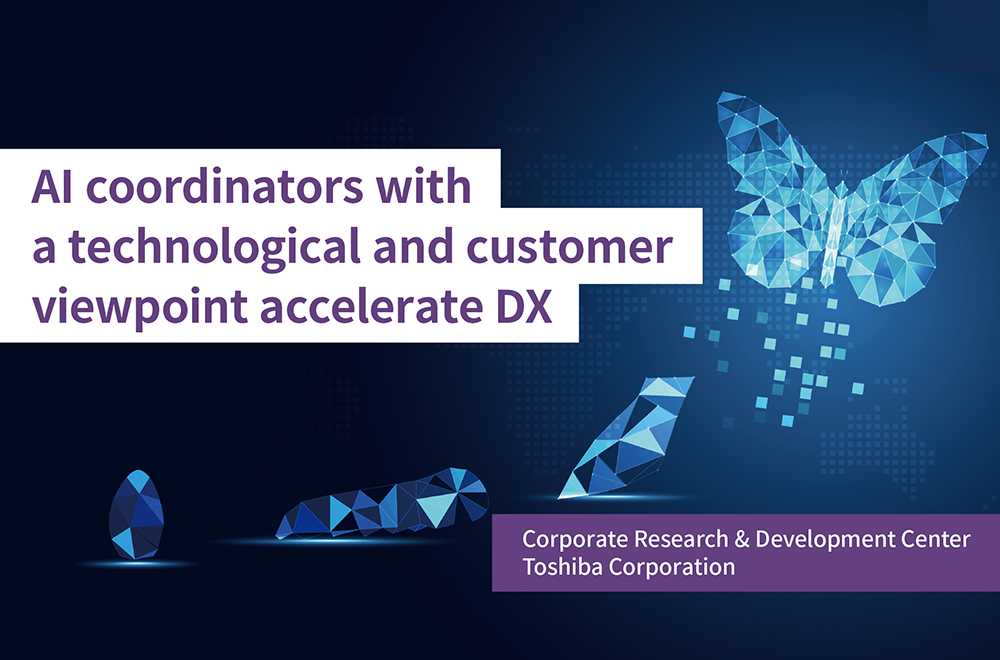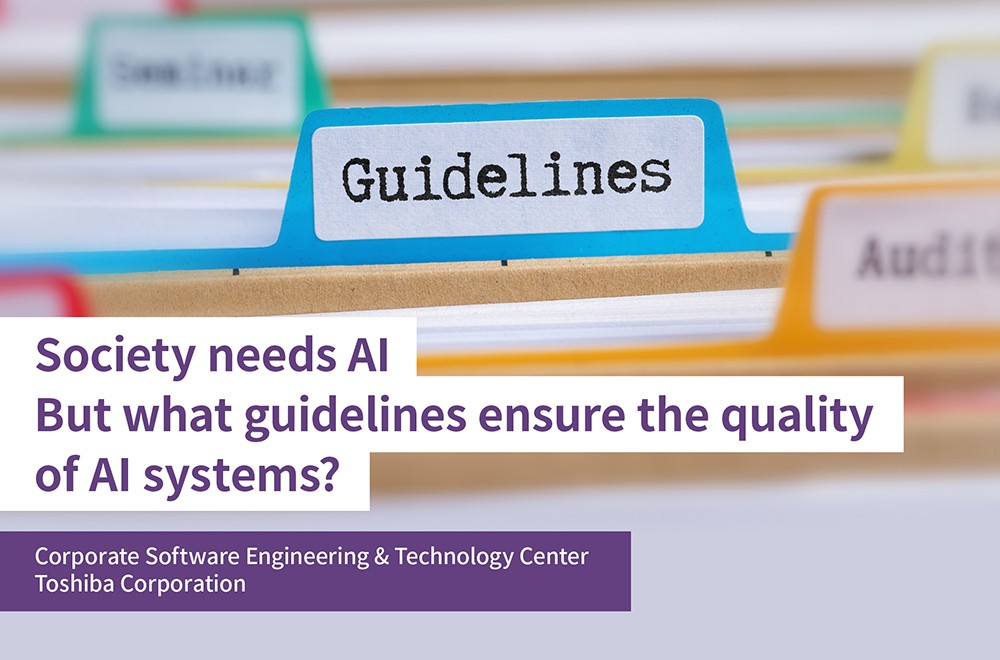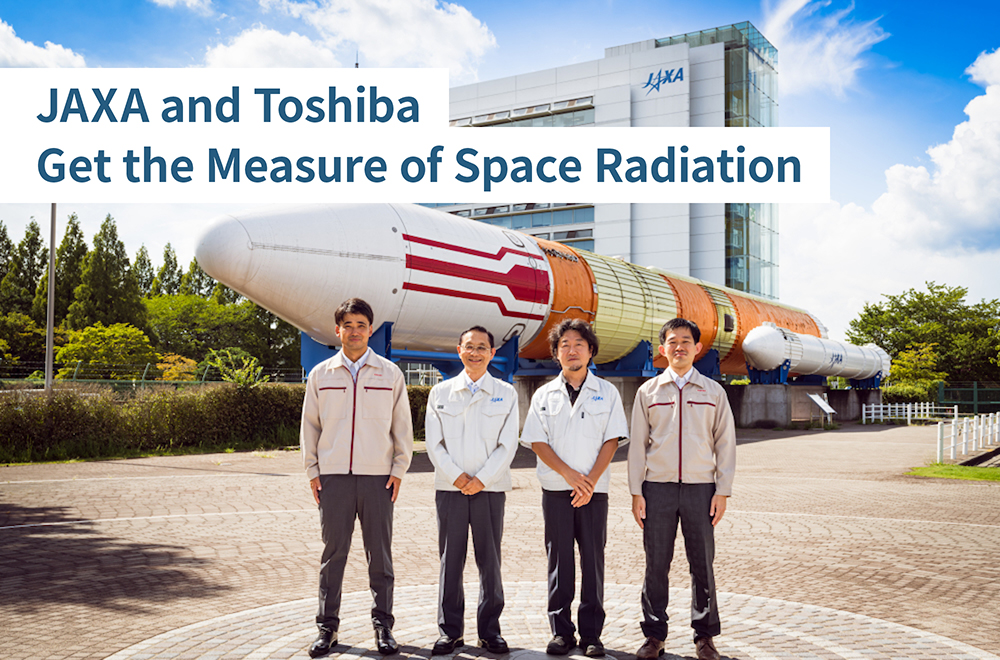Toshiba’s Young Engineers -Creating a Society where Everyone can Develop High-quality AI
2023/12/15 Toshiba Clip Team
- Now we can all develop AI, we need to reconsider the definition of AI quality
- Creating mechanisms that let everyone develop high quality AI
- Progress in AI contributes to society and brings convenience to daily life
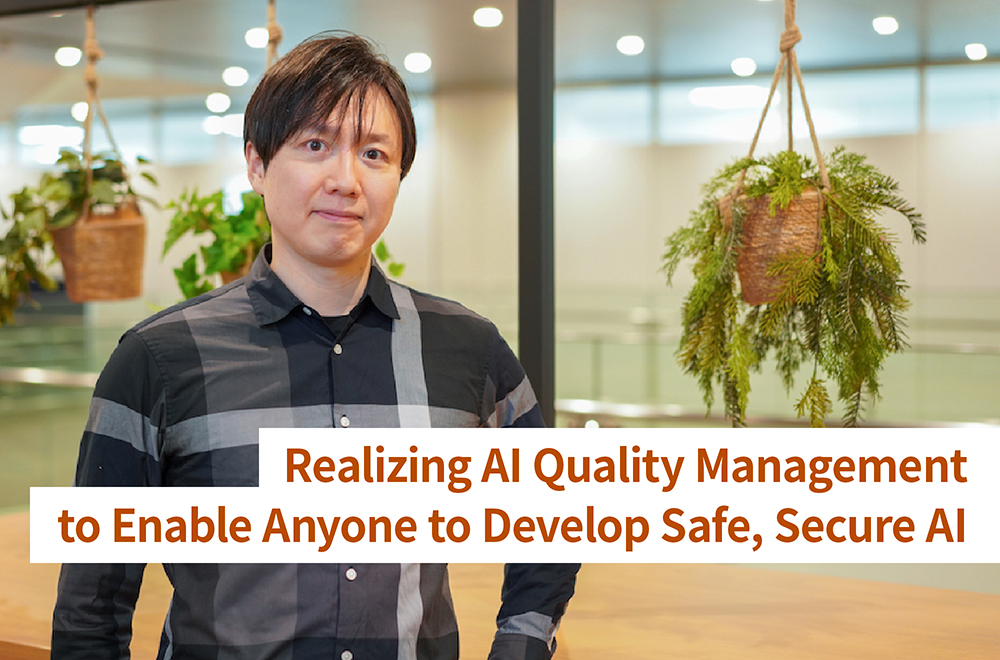
Technology advances have carried AI beyond the familiar areas of voice recognition and synthesis and image recognition into many new areas. Industry is applying it to boosting factory productivity, and to inspection and maintenance that ensures the soundness of infrastructure; in medicine it is predicting the risk of illness. Recent progress includes not only the search and analysis of documents but also the ability to generate documents.
Along with this, there are now whole libraries of open source products for AI development that are widening its scope of application. However, this is making AI quality a matter of concern, and underlines that factors that include result accuracy, ethics and security must be integral to the development process. Determining how to realize AI quality management that ensures the consistent quality and reliability of products and services using AI is the foremost challenge facing AI development and use.
This series focuses on initiatives by determined young engineers working in a many fields. In this article, we speak to Hidetaka Ohira, who researches AI quality assessment at Toshiba’s Corporate Research & Development Center. He shows us a vivid picture of a new form of quality management to underpin the era of AI.
What exactly is AI quality?
AI is successfully making its way into more and more areas, including prediction of future health status, factory automation, and streamlining the transcription of recorded infrastructure inspections. It is an increasingly essential tool for finding solutions to issues society faces, and improving daily life.
“With the use of AI becoming increasingly common in society, AI research and development has become very open, and now many people are involved,” says Hidetaka Ohira, who is working on the development of AI at Toshiba’s Corporate Research & Development Center. “Previously, a subset of researchers and engineers with specialist skills did the work, but AI is now gaining the universality of a technology that many people can use.
But this brings its own problem. Until now, researchers and engineers used their specialist skills to manage quality, but once non-specialists can create AI, whether or not quality can be maintained becomes a big question.”
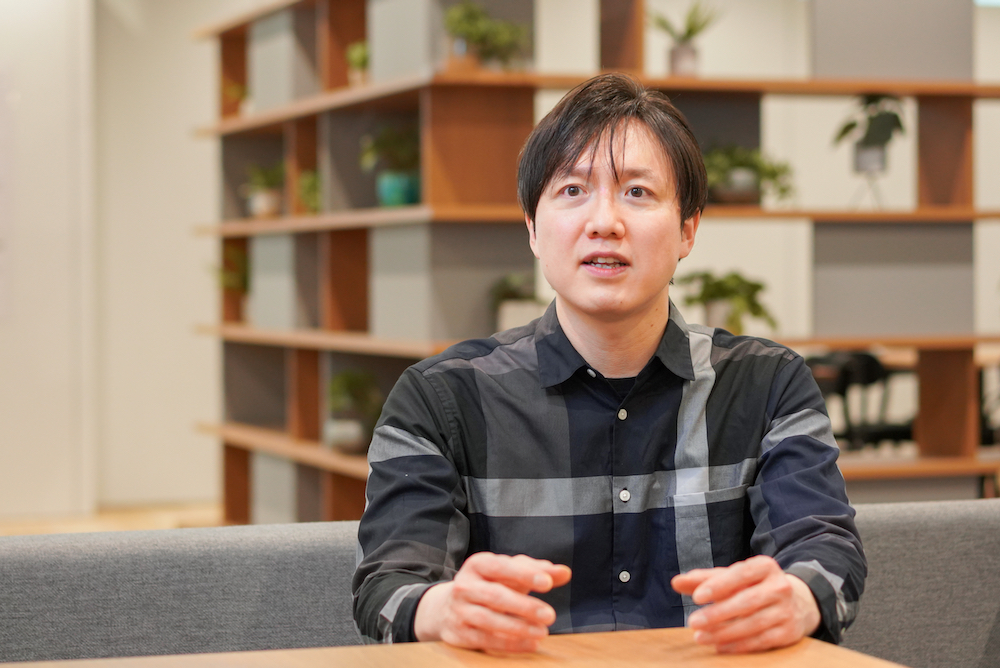
Hidetaka Ohira, Specialist, AI Application Dept., Advanced Intelligent Systems Technology Center, Corporate Research & Development Center, Toshiba Corporation
We have already seen the AI of self-driving vehicles mistakenly recognize oncoming vehicles as road signs or being misled by the patterns in road surfaces. Recruitment support AI has used gender to reject candidates. The issue of how to ensure, AI quality grows in parallel with its wider adoption.
“But beyond errors caused by AI itself. the potential danger posed by bad actors intentionally confusing AI to cause damage is also becoming increasingly apparent. If, for example, AI-based facial recognition for access control is used with malicious intent to allow entry by unauthorized persons, it could result in serious security issues.”
Mainstream AI learns from identifying patterns in massive amounts of data and constructing models. It then produces output, as decisions. Well known examples of this are Go and shogi AI that analyze huge volumes of game records to determine the best possible moves. However, if unsuitable data is used for training, then problems occur in decision making. Even with appropriate data, the AI will not behave as designed if there is a problem in the learning method. And this is where the quality of AI is tested.
What can we do to enable anyone to create high-quality AI?
Maintaining the quality of AI is difficult because it learns from data, which makes it very hard to define its operation with specifications defined by a person. Put another way, it is difficult for us, for people, to perfectly control AI decisions. For example, AI cannot necessarily accurately recognize handwritten characters, as in the illustration below.
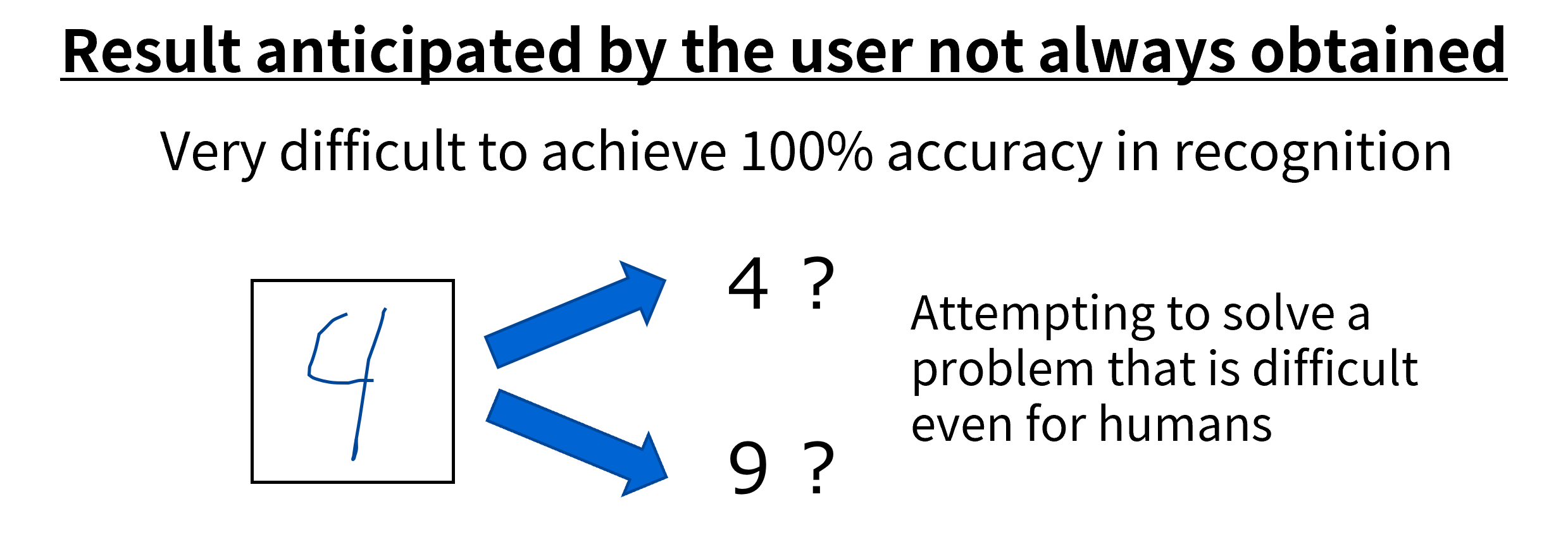
Quality management still presents issues that need to be addressed when it comes to AI, as the basis for its decisions is unclear.
How AI learns from data and makes decisions is a black box; we cannot see into it or explain it (explainability). On top of that, if poor data is used to train AI, bias can creep into its decisions: it may make a negative decision based on an attribute, such as rejecting someone for a loan simply because they are a student, raising concerns for lack of fairness; if the trend in the data used changes, its performance may deteriorate; and slight variations in images can cause AI to mistake a human for an animal, indicating poor accuracy and robustness. These potential problems are illustrated below.
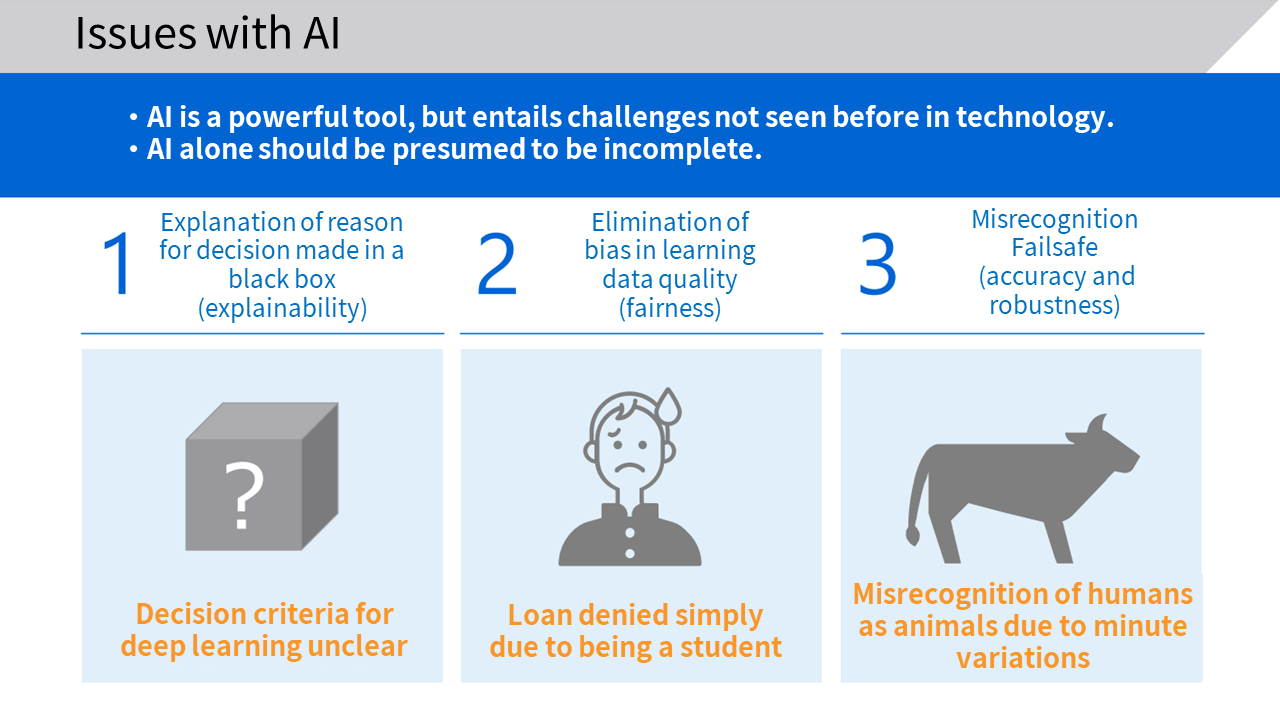
Three typical challenges in AI
AI quality is a stringent requirement in every phase, from design and development through to deployment, and AI researchers worldwide are caught up in a lively discussion on how best to assess and ensure AI quality. The big question is how to maintain quality over the long run?
“When we talk about guaranteeing a high level of quality in AI, there are a broad range of points to think about, not just accuracy. We have to consider the black box and ethical, and whether it will work as desired. In the real world, AI is often used in environments that weren’t assumed in development, something I’ve had to struggle with. Specialists involved in AI need to have a broad perspective and consider a wide variety of risks.”
AI quality management starts with determining what needs to be done for each stakeholder. After this, the quality management processes are confirmed, and technology for comprehensively identifying perspectives needed to check quality is developed. Finally, the results of the quality assessment are visualized and shared with the customer.
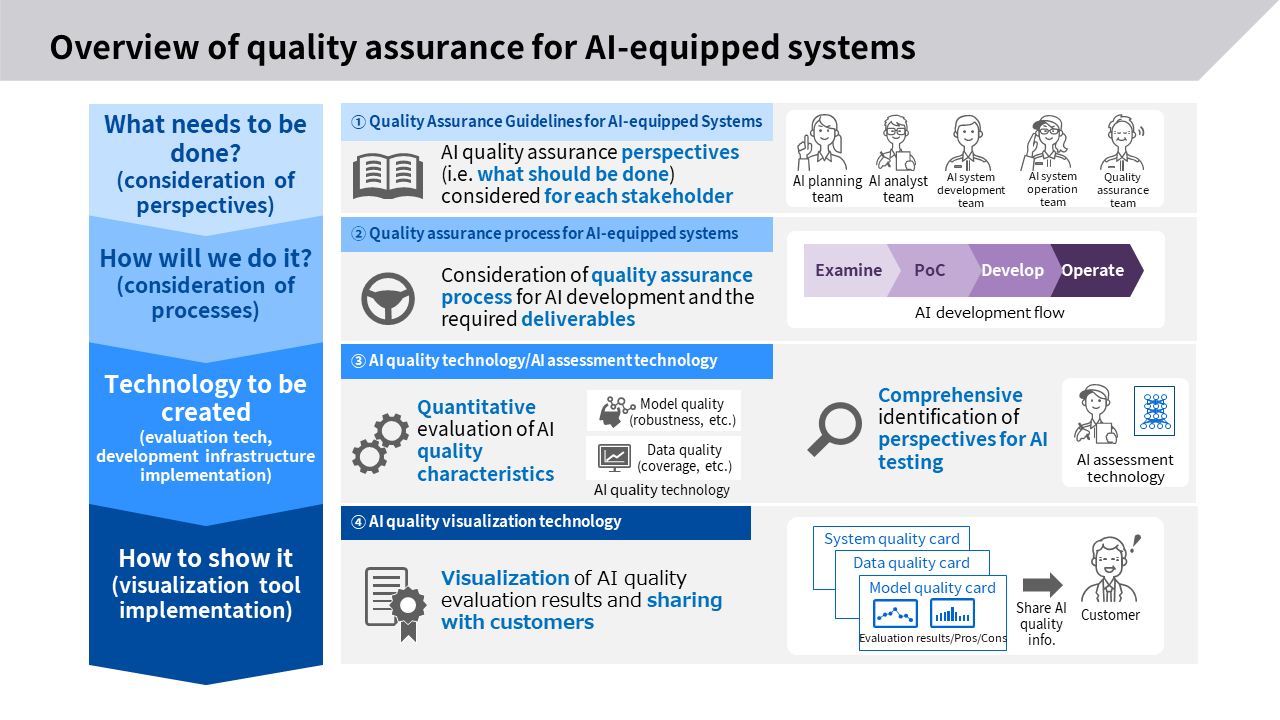
AI quality is assured through every phase
“My mission is to investigate the evaluation and improvement methods required to enable non-specialists to develop high-quality AI, and to develop assessment and improvement technology.”
Ohira focuses his development of AI quality assessment technology on the goal of achieving widespread use of Toshiba Group’s Quality Assurance Guidelines for AI-equipped Systems and the company’s assessment methods,” and establishing and sharing the development process. His team works with AI engineers from business departments and people in teams responsible for establishing development processes, and provides firm support for AI.
“General principles that define the performance and qualities required of AI are being formulated in Japan and overseas, toward safe, secure use of AI. Japan has its Social Principles of Human-Centric AI and Guidelines for the Use of AI, and overseas there are the draft European AI regulations and other proposals. Toshiba has formulated an AI governance statement, and promotes AI use and quality management that are in line with its principles. We are also developing AI quality assessment technology and putting in place processes to establish a continuing mechanism for maintaining AI service quality.
“The EU is discussing draft regulations for AI that aim to prevent discrimination through the improper use of AI and privacy violations. In Japan, the government has defined guidelines, including the Ministry of Economy, Trade and Industry’s Governance Guidelines for Implementation of AI Principles, and is considering the appropriate use of AI, including in development work. We are working on how to align with these trends and ensure a fit with AI research and development. We are promoting internal awareness and keeping a close eye on major movements.”
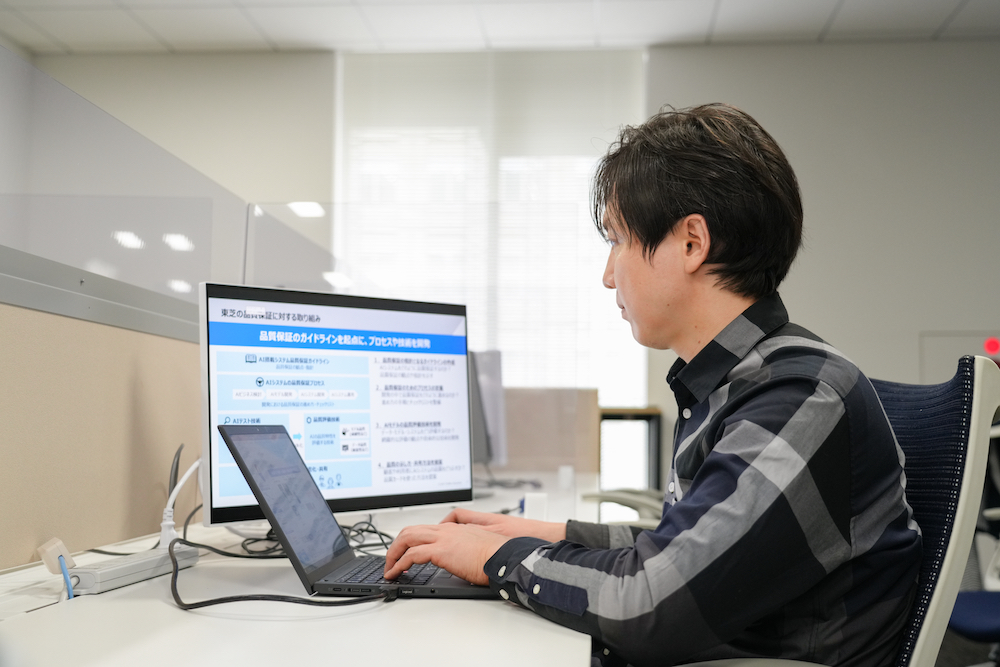
Creating rules where there were none before makes it interesting.
Ohira’s deep interest in AI dates back to university, when he did a lot of research into recognition of maps and road signs. He decided that he wanted to combine this work with image recognition, and to contribute to finding solutions to challenges facing society. He joined Toshiba, because of its proven track record in AI R&D.
In 1967, Toshiba developed the world’s first mail sorting machine to use optical character recognition (OCR), and since then has consistently devoted resources to researching image recognition and other aspects of AI, even in difficult economic circumstances. This sparked Ohira’s interest. He joined the company convinced that sharing an environment with AI specialists would allow him to increase his knowledge and build his skills.
Assigned to the Corporate Research & Development Center, Ohira’s initial assignments included AI to determine levels of crowding, and to recognize types of waste in images. As he built up his knowledge base and expertise, he came to see the opacity in how AI reaches decisions as a concern, and that it is necessary to ensure that AI aligns with human intentions while maintaining solid product quality. This challenging field of study is also at the center of current academic research. Ohira looks pensive when he talks about being involved in such front-line work.
“Look at cutting-edge AI development, and you see the border between image recognition and voice recognition disappearing,” says Ohira, “There is an increasingly active movement toward fusing technologies to improve results. A model is emerging where the ideal engineer is someone who goes beyond a specialty to work in many fields. They refine their skills across the board, and makes products produce better results.
The number of fields where AI is considered necessary will grow, so we have to think about how to incorporate it into society in circumstances where lots of people are involved in its development. Companies are feeling their way forward, but there is no work as interesting as making rules from scratch. There are difficulties, but it’s very meaningful work.”
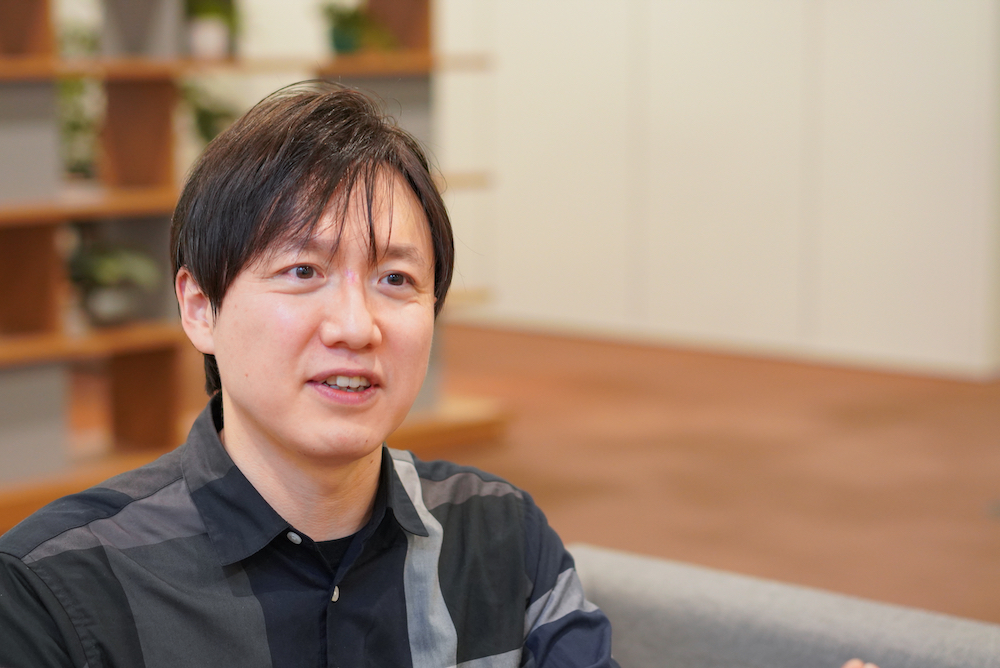
Toshiba, a company that emphasizes technology as infrastructure for creating products, provides the cultural foundations for Ohira’s work. The Corporate Research & Development Center shares the latest papers across departments, and is proactive about making presentations at international conferences. “Any improvements in my skills are due to effort and determination rather than originality,” says Ohira with a laugh. “That and the inspiration of working alongside people who are really dedicated and passionate about what they do.”
Ohira’s target is AI quality assessment technology that customers can use with peace of mind, and his focus is on the society that will receive the benefits of AI. One project that succeeded in this aimed to improve efficiency at waste disposal facilities, where factors included increasing environmental awareness, tightening regional finances, and fewer experienced personnel, due to Japan’s aging society. The solution was found in image recognition technology built into a fully automated waste crane system. Ohira used images of large volumes of waste piled up in disposal facilities to realize a technology that recognized types of waste, how they were mixed together, the height of waste piles, and other properties. Even with a complex crane control requirement, the technology secured highly accurate and efficient waste churning and re-stacking.
“Obviously, we need to continue to improve AI and increase its accuracy, and also to think about how to further its social acceptance. If we consider how to promote its widespread use, and how we want people to use it, we will end up with easy-to-use technology. I want a world where safe, secure AI can be easily by anyone anywhere, and I intend to continue to work on this through a process of trial and error.”
Ohira’s challenge to create a new normal for AI has a way to go.
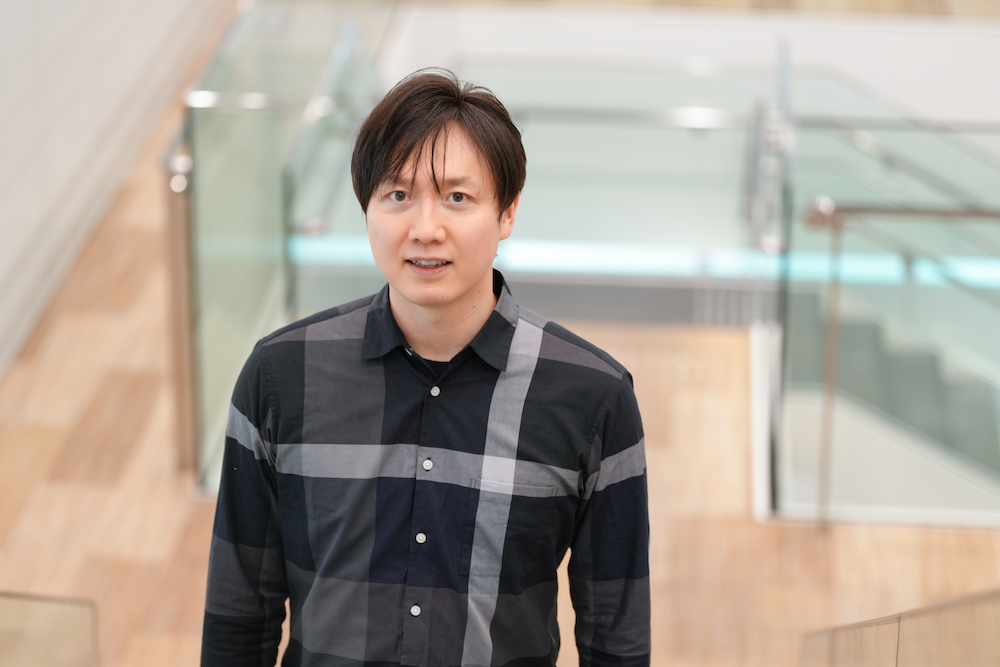
![]()





